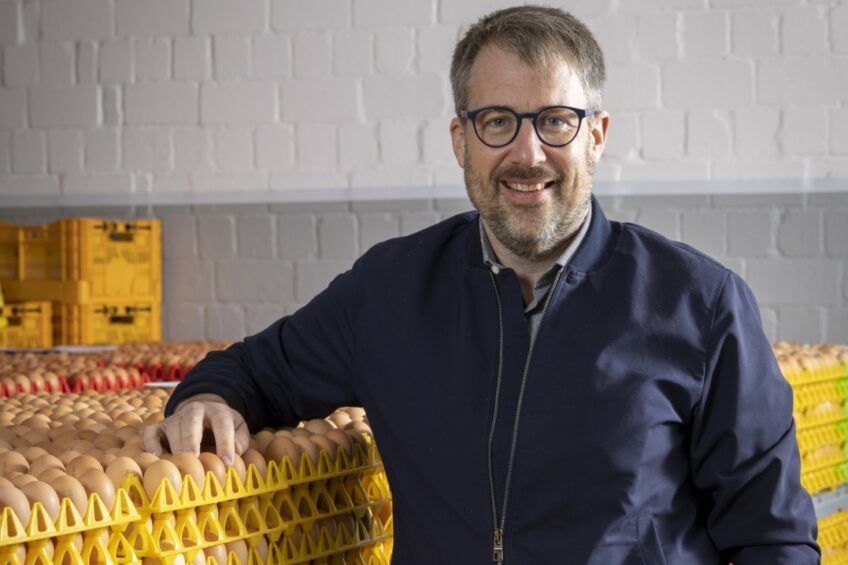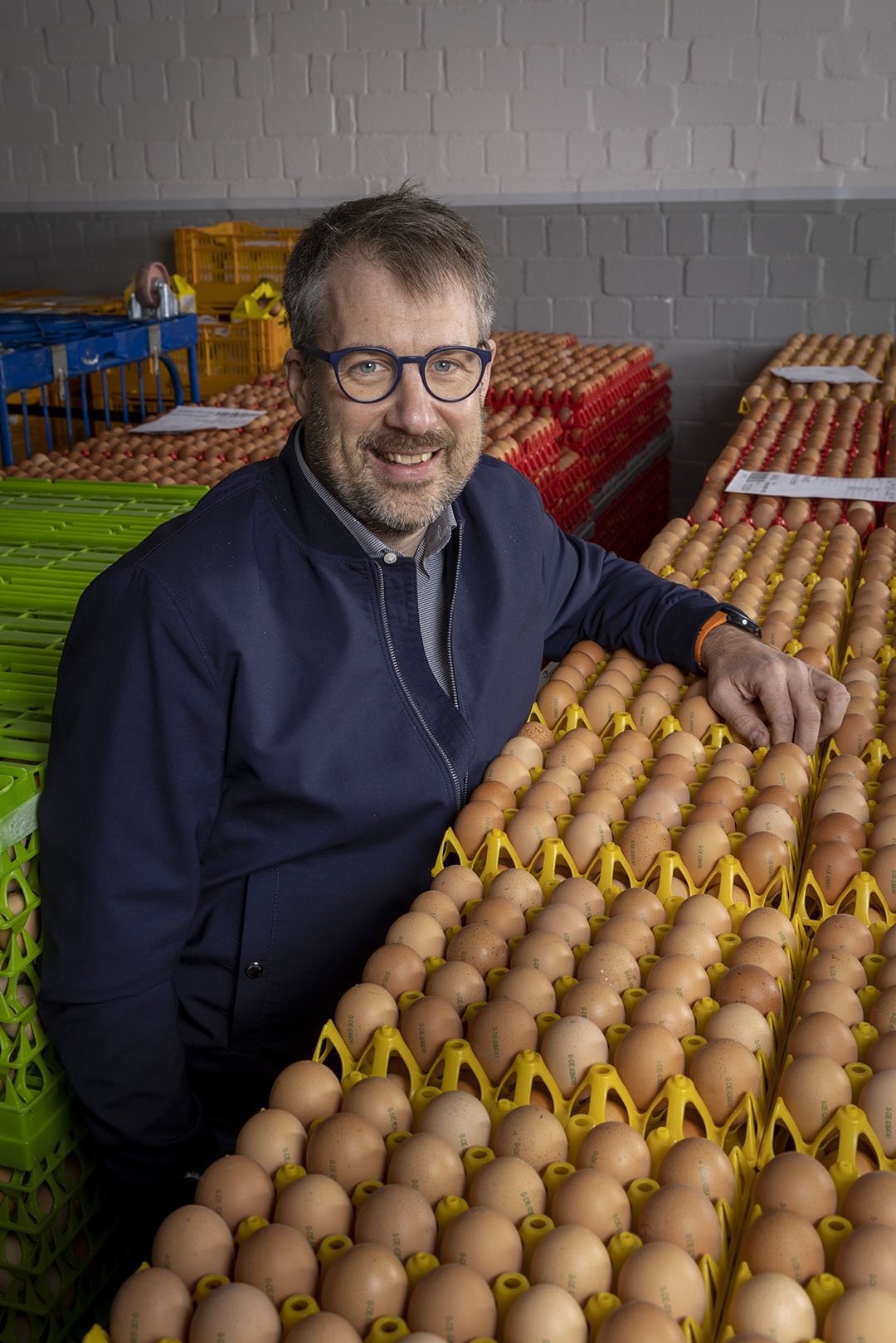Germany: ‘Only a few hatcheries will survive’

The German layer industry foresees a troublesome future. As from 1 January 2024, all male layer siblings must remain alive, which asks for great investments in in ovo sexing machines. Since 2021, the number of hatcheries has already shrunk from 20 to 8, and further restructuring is imminent.
Chairman Henner Schönecke of the German branch organisation for the laying sector, Bundesverband Ei, is proud of the German laying sector, but he is concerned about its future. “In terms of poultry farming, Germany could be compared to a Ferrari. We had the world’s leading geneticists. All breeding stock and techniques came from Germany, but they are not here anymore. We have new modern layer farms and the best-performing hatcheries. We hardly have any laying hens in enriched cages. Most of them are in aviary housing systems and a considerable portion is in free-range or organic farming.”
“Really,” he says, “everything meets and exceeds the highest standards worldwide. We do more for animal protection and welfare in Germany than anywhere else. However, the requirements in this regard make production too expensive. The egg supply chain is now increasingly moving abroad, where all these topics do not come into play or will only come into play later. That’s the dilemma. As a trade association, we have warned about this time and time again, to no avail.”
How has the German layer industry developed?
We have always been a net importer of eggs and egg products; we are even the world record holder for egg imports. The self-sufficiency rate is now about 73%, meaning a quarter of the eggs we eat come from abroad. That has already decreased considerably because the self-sufficiency rate in 2010 was only 55%.
In 1990 there were about 75 million hens in Germany; now there are only 55 million. The greatest shrinkage occurred at the time of the mandatory switch from cage farming to alternative housing systems. In Germany, this had to be done before 2008, in Europe 2010 was the end date.
In 2016, the voluntary stop on beak trimming took effect. Since then no beaks have been cut in German hatcheries. We would also have liked such a voluntary, market-driven scheme for killing day-old male layer chicks.
What’s the status on male layer siblings?
The Bundesverwaltungsgericht (high court) ruled in 2019 that we should stop killing male layer siblings if there is a technical solution available for early sex determination. At that time there wasn’t, but knowledge and engineering has come a long way since then. The CDU minister of Agriculture subsequently banned the killing of day-old chicks from 1 January 2022. This law is based on 2 methods of detecting male birds, both late in the hatching process.
After that, the law was tightened. From 1 January 2024, in ovo sex determination must take place before the 7th day of incubation. There is no commercial technical solution for this yet. As a result, from 1 January onwards, we will have to raise all layer males if we still want to have hatcheries in Germany.
What is the origin of that 7th day rule?
It comes from having too much faith in technology. The researchers were just too optimistic about ‘Raman spectroscopy’ being able to effectively detect sex on the 4th day. It would soon be on the market. However, it was already clear when we were in the legislative process that this spectroscopy would not come to market before 2024, because it gives too many false positives.
What is the consequence of this?
The legislation is already casting a long shadow ahead of itself. Of the 20 layer hatcheries that were active in 2021, only 8 now remain. As a result, fewer layer chicks are being hatched – only 25 million last year. This means that we only hatched half the 55 million layers in Germany. The rest were imported. We expect the share of ‘German hatched’ chicks to fall even further if the policy remains unchanged.
And, of course, no one is investing in hatcheries anymore given the 2024 deadline. If the law is not amended, only a few hatcheries will remain that hatch both laying hens and the male siblings. All others will disappear. That’s the dilemma we are facing.
Is a postponed start date an option?
The Ministry of Food and Agriculture must submit a status report in spring 2023 indicating whether sex determination is practically available before the 7th day of incubation and from which day the embryo experiences pain stimuli. Parliament can respond to that but does not have to.
We are now trying to convince the political parties and regional governments that 2024 is not feasible. As united egg producers, we are fighting for this because we have to have hatcheries in Germany if we are to keep our business alive, otherwise a lot of value in the chain will be lost. An egg chain simply cannot do without hatcheries.
What is feasible with such a rigorous ban: 2025, 2027 or 2030?
As the industry we cannot set a deadline; only the researchers who work on the technology can do that. In our view, setting a date is also the wrong approach. There is one European market which is why this chick-killing problem must be solved at a European level. European animal welfare organisations are already pleased that France is doing hyperspectral analysis on day 13. They say that solves the male layer problem. In Germany we want to do it completely ethically right from the start.
The 2019 judgment only said we must end chick killing. It didn’t tell us to look at the incubation process, whether the embryo in the egg experiences pain or when is the right time to kill it. It’s only about ending the killing of day-old chicks. We have already achieved that, and it must continue to be so. We are the world market leader if we can do it the way we do. No other country can match how we have set it up.
There are operational detection techniques for determining the sex of the hatching egg on the 9th day of incubation. Why not go with that?
Yes, but there is too much resistance to that, so it is no longer feasible. The German animal welfare organisation and its affiliated organisations in other countries do not think that is the right way. They argue that we should move to dual-purpose laying hens, to breeds that are genetically predisposed to reasonable daily gain and also have good egg production. They think we are working with the wrong genetics.
What chance do you give their ideas?

New dual-purpose varieties have been introduced onto the German market. The largest flock that is now kept in Germany consists of 7,000 hens. So, virtually no chance. The problem is that these dual-purpose birds only lay 220 eggs a year, at most 2-thirds of what the current production varieties produce. But an even bigger problem is that they are miniscule eggs. The consumer does not want that.
And the males? They grow faster than a cockerel of a classic laying hybrid, but the grow-out period is still long with high feed consumption. Its flesh is very firm and looks different from the usual. The question is whether you will find a market for that.
Where will we be in 3-5 years?
The size of the German egg market will hardly change. Animal welfare remains an item; we have to focus on that in Germany. Things are already well organised in the table eggs market. There are many labels and explanations on the packaging in the supermarket: origin, were the siblings killed, how the eggs were stored, etc. In the case of pasta, baked goods and the like, however, there is no labelling scheme for the origin and holding of the processed egg products. We are pushing hard for the industry to mention that, too.
If we have to run such an expensive farm in Germany, that should also be reflected in the processed product. A retailer that says “I only sell OKT (ohne kuken toten/without killing male chicks) eggs” should demand the same for all processed products. At least for the products under its own private labels. Because they have influence over that. You cannot legally enforce this – it affects free trade and the open market within the EU.
We can make a law that prohibits the killing of chicks in Germany; that has been done. But the state cannot prohibit the sale of an egg or egg product from hens where the males have been killed. The state can enforce transparency about production methods: with or without killing male chicks. Then you let the consumer decide. Then it’s fair.
Will the consumer pay for it?
The consumer has the money for it. We certainly have segments of the population that need to watch every penny. But an OKT egg costs between 1.5 to 2 cents more than a regular egg in the store. With a consumption rate of 200 eggs per year, that is less than €4. The price difference cannot be an argument.
Will Germany continue to import non-OKT hens?
Yes. We are allowed to import them because they are freely tradable according to European legislation. They can also be used to produce eggs. The brothers of roughly 30-40% of the 55 million laying hens in Germany were killed as day-old chicks. That share will remain this high, hatcheries and traders tell us. It is even growing in some sectors. After all, there are still customers who do not care.
The Netherlands exports a lot of eggs and hens to Germany. Should they worry?
I admire the Dutch commercial spirit. The 3 major integrations adapt very precisely to their markets. Dutch egg producers that supply the German market produce under KAT supervision. Hatcheries set or tighten requirements. Statistics show that 90% of the males for OKT production that hatch in the Netherlands are not grown in the Netherlands but in Poland. So they go straight through Germany to Poland. That shows precisely the dilemma we are facing right now.
From 2024 we have to rear the males under KAT rules, something that is actually completely undesirable because we cannot raise those males in Germany. We don’t have the capacity, so the Poles have to do that. The only thing the ban will lead to is an increase in animal transport in order to be able to hatch laying hens in accordance with the law. That cannot be the purpose of the scheme.
Join 31,000+ subscribers
Subscribe to our newsletter to stay updated about all the need-to-know content in the poultry sector, three times a week. Beheer
Beheer











 WP Admin
WP Admin  Bewerk bericht
Bewerk bericht